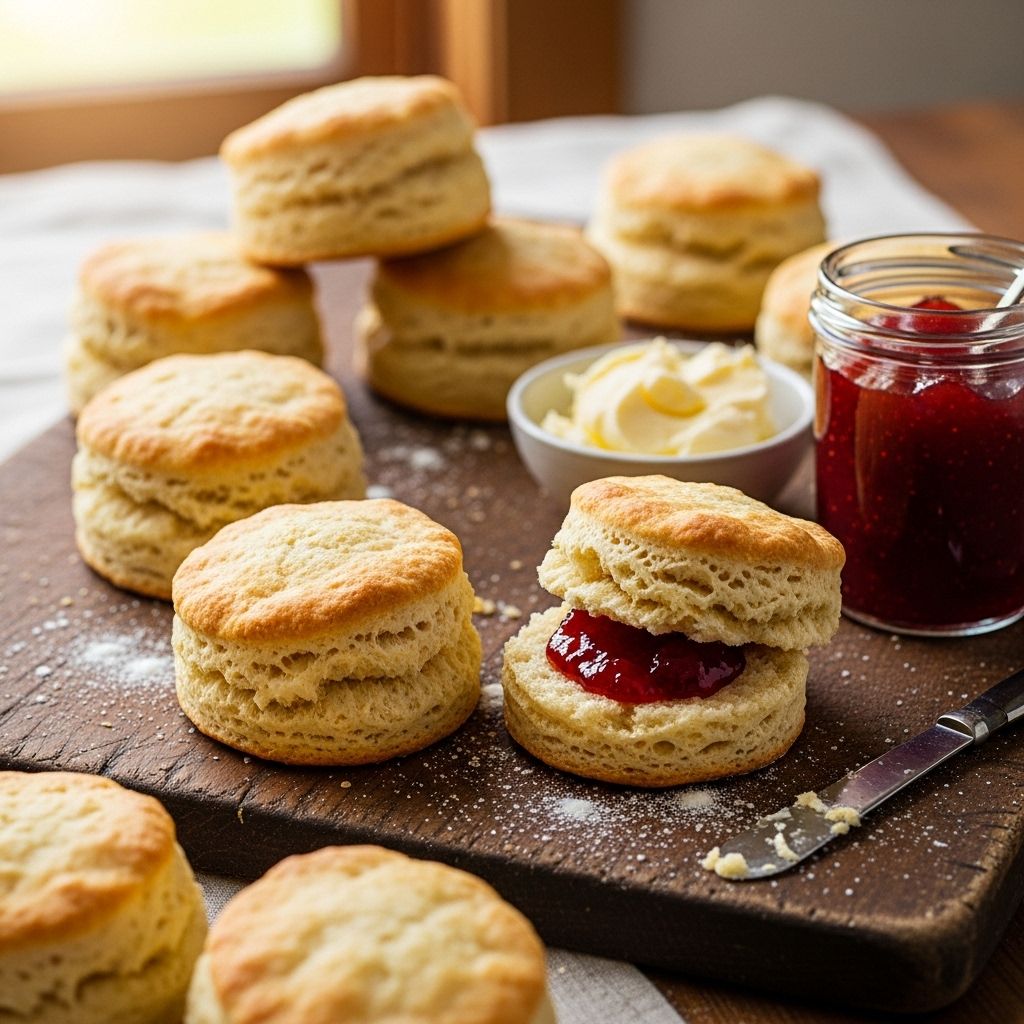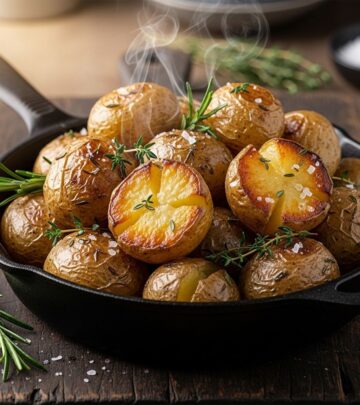Buttermilk Biscuit Recipe: 8 Steps For Flaky, Tender Perfection
Master the art of tender, flaky buttermilk biscuits with Chef John's foolproof method and pro baking tips.

Image: HearthJunction Design Team
Chef John’s Ultimate Buttermilk Biscuits
If you’ve been searching for the perfect homemade buttermilk biscuit, look no further. Chef John’s classic buttermilk biscuits are a favorite among home bakers and professionals alike, celebrated for their mile-high flakiness, rich buttery flavor, and unbeatable tenderness. Whether you’re a seasoned baker or a kitchen novice, this guide will walk you through every step — plus share expert baking tips, common substitution tricks, and answers to all your biscuit questions.
Why Every Baker Needs a Great Buttermilk Biscuit Recipe
There’s something irresistible about a fresh, warm biscuit — crisp on top, pillowy inside, and perfect for any meal. Biscuits can elevate breakfast, complement a hearty dinner, or serve as the star of their own show. Chef John’s buttermilk biscuits are designed to be easy, reliable, and delicious every time. His technique ensures the kind of flakiness and tender crumb that will have everyone reaching for seconds.
Buttermilk Biscuits vs. Cream Biscuits: What’s the Difference?
| Feature | Buttermilk Biscuits | Cream Biscuits |
|---|---|---|
| Main Liquid | Buttermilk (acidic and flavorful) | Heavy cream (mild and rich) |
| Taste | Tangy, rich flavor | Mild, creamy flavor |
| Texture | Tall, flaky, tender | Softer, less flaky |
| Ease of Preparation | Moderate; requires cold butter handling | Simpler; no butter cutting in |
| Rise | Higher rise due to acid-leavener reaction | Lower (unless boosted with extra leavener) |
Buttermilk biscuits rely on acid–base chemistry: the acidity in buttermilk reacts with baking powder and soda to create extra lift for a flakier, taller result. The tang from buttermilk is signature. Cream biscuits use heavy cream instead, producing a more subtle flavor and a slightly denser, softer crumb. If you’ve always wondered why classic biscuits taste so rich and rise so high, buttermilk is the secret.
Chef John’s Buttermilk Biscuits: Ingredients You’ll Need
- All-purpose flour: The foundation of your biscuit structure. For extra-tender biscuits, avoid overmixing.
- Baking powder & baking soda: These leaveners interact with buttermilk’s acidity to give biscuits their fluffiness.
- Salt: Essential to wake up all the flavors.
- Unsalted butter (chilled): Cold butter in the dough results in the classic flaky layers. Freezing or chilling is key.
- Buttermilk (chilled): Adds tang, reacts with leaveners, and ensures biscuits are moist.
The full ingredient quantities are:
- 2 cups all-purpose flour
- 2 teaspoons baking powder
- 1/4 teaspoon baking soda
- 1 teaspoon salt
- 7 tablespoons unsalted butter, chilled and cut into small cubes
- 3/4 cup plus 1 tablespoon cold buttermilk (divided)
Step-by-Step: How to Make Chef John’s Buttermilk Biscuits
- Preheat Your Oven: Set oven to 450°F (230°C). Line a baking sheet with parchment for easy cleanup.
- Mix the Dry Ingredients: In a large bowl, thoroughly whisk together the flour, baking powder, baking soda, and salt. This distributes the leaveners evenly and prevents clumping.
- Cut in the Butter: Add the very cold butter cubes. Using a pastry blender, two knives, or your fingertips, work butter into the flour until the mixture looks coarse, with pea-sized bits of butter visible throughout. These pockets of butter are the key to flakiness.
- Add the Buttermilk: Pour in 3/4 cup buttermilk. Stir gently until just combined, being careful not to overwork the dough. It should look shaggy and barely come together.
- Turn Out and Fold: Lightly flour your surface. Gently turn out the dough and pat it into a rectangle, about 1/2 inch thick. Fold the dough into thirds like a letter, turn it a quarter-turn, flatten again, and repeat the folding once or twice. This creates those distinct layers.
- Cut Biscuits: Pat dough to about 3/4-inch thickness. Use a floured round cutter (about 2 inches) to cut biscuits, pressing straight down (no twisting — it seals edges and prevents rising). Gather scraps for one more gentle round of cuts.
- Prepare for Baking: Place biscuits close together on the lined baking sheet. Using your thumb, press a shallow indent in the top of each biscuit (this helps them rise straight). Brush the tops with the reserved buttermilk for extra browning.
- Bake: Bake 15–18 minutes, or until biscuits are golden brown and beautifully risen. Serve warm with butter, jam, sausage gravy, or honey.
Chef John’s Tips for Flaky, Sky-High Biscuits
- Keep everything cold: Chill your butter, buttermilk, and even your flour for best results, especially on hot days.
- Don’t overmix: Overworking activates gluten, making biscuits tough. Mix until just combined and shaggy.
- Fold the dough: Folding (or “laminating”) the dough creates visible layers. Two or three folds are perfect.
- Use a sharp cutter: Dull edges can press the dough and reduce rise. Press straight down — avoid twisting.
- Oven temperature matters: Biscuits love a hot oven. A high initial heat provides the best rise and browning.
- Brush tops only: Don’t coat the sides with buttermilk or butter before baking, as this can inhibit rising.
- Serve fresh: Biscuits are at their tender, flaky best straight from the oven.
Common Biscuit Mistakes (and How to Avoid Them)
- Butter isn’t cold enough: If butter melts before baking, you’ll lose flakiness. Work quickly, and use chilled butter.
- Overmixing the dough: Stop mixing once the dough just comes together. Kneading too much leads to tough biscuits.
- Baking at the wrong temperature: Too low, and biscuits won’t rise; too high, and they may brown before baking through. Stick to a hot, preheated oven (450°F).
- Twisting the cutter: Always press straight down for tall, even biscuits.
- Overcrowding or spreading biscuits: For soft-sided biscuits, place them close together; for crisper edges, space them apart.
Serving and Storing Homemade Biscuits
Fresh biscuits are best enjoyed warm from the oven. Here are some serving and storage tips:
- With butter and jam: A classic pairing for breakfast or tea.
- As a base for sausage gravy: The Southern staple, biscuits and gravy, is pure comfort.
- With honey or maple syrup: Sweeten things up for brunch.
- For sandwiches: Split biscuits and fill with ham, egg, or fried chicken for hearty handhelds.
- For dessert: Use biscuits as shortcakes, topped with whipped cream and berries.
To store, keep biscuits in an airtight container at room temperature for up to 2 days. For longer storage, wrap and freeze. Reheat briefly in a hot oven to restore flakiness.
Substitutions and Variations
- No buttermilk? Mix 1 tablespoon lemon juice or vinegar into 1 cup milk. Let sit for 5 minutes before using.
- Make sweet biscuits: Add 2–3 tablespoons sugar for a dessert-style biscuit.
- Add cheese or herbs: Fold in shredded cheddar, chives, or parsley for a savory twist.
- Gluten-free: Use a 1:1 gluten-free flour blend, but be aware texture may change.
- Vegan option: Substitute cold vegan butter and non-dairy buttermilk (plant milk plus acid).
Frequently Asked Questions (FAQs)
Can I use self-rising flour instead of all-purpose and omit baking powder?
Self-rising flour contains baking powder and salt. If using, adjust the recipe to skip added leaveners and salt, but flavor and texture may differ from Chef John’s preferred balance.
Why should butter and buttermilk be cold?
Cold ingredients prevent the butter from melting before baking. During baking, cold butter steams and creates separate layers, producing maximum flakiness.
What if I don’t have a round biscuit cutter?
You can use the rim of a drinking glass or cut the dough into squares with a sharp knife — no waste or rerolling required.
Should I twist the cutter when cutting biscuits?
No. Twisting seals the biscuit edges, preventing a proper rise. Always press straight down for tall, fluffy biscuits.
Can I freeze biscuit dough before baking?
Yes! Arrange cut biscuits on a baking sheet and freeze. Once solid, store in a bag. Bake from frozen, adding a few extra minutes to the time.
Why did my biscuits turn out tough?
Usually, dough is overmixed or overhandled, resulting in gluten buildup. Mix until just combined and use a gentle touch.
How do I get extra-tall biscuits?
Multiple dough folds, a hot oven, and placing biscuits close together help them rise straight and tall.
Nutrition Facts
A typical buttermilk biscuit contains about 180–200 calories each, depending on size and ingredients. They offer carbohydrates, a bit of protein, and some fat — mostly from the butter, which also provides flavor and texture.
Chef John’s Final Thoughts: Biscuit Baking Success
Mastering buttermilk biscuits may seem simple, but it’s all about careful technique and quality ingredients. Follow Chef John’s recipe, use very cold butter and buttermilk, avoid overworking the dough, and bake in a hot oven — you’ll be rewarded every time with tender, flaky biscuits worthy of any occasion.
So preheat your oven, gather your ingredients, and start your own biscuit tradition — delicious memories are just 20 minutes away.
References
- https://www.allrecipes.com/recipe/220943/chef-johns-buttermilk-biscuits/
- https://www.pinterest.com/pin/87327680262925341/
- https://www.scribd.com/document/859769115/Chef-John-s-Buttermilk-Biscuits-Allrecipes
- https://www.pinterest.com/pin/407575835044263755/
- https://www.allrecipes.com/recipe/18504/buttermilk-biscuits-ii/
Read full bio of Anjali Sayee












